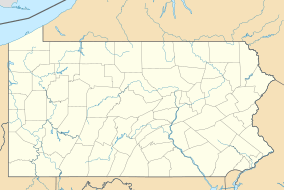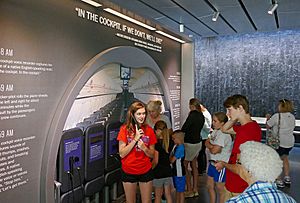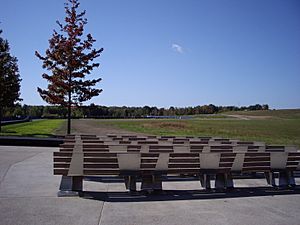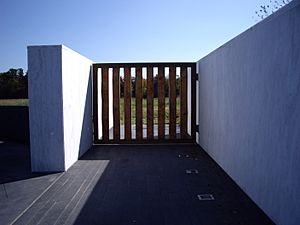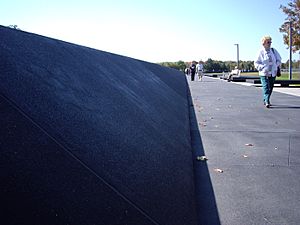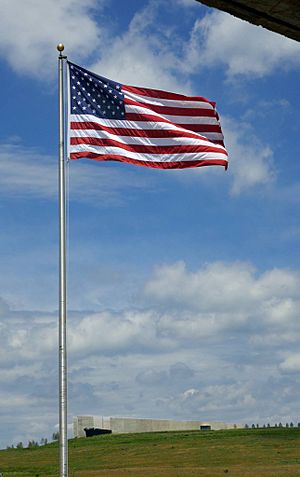Flight 93 National Memorial facts for kids
Quick facts for kids Flight 93 National Memorial |
|
|---|---|

The white marble Wall of Names positioned on the flight path
|
|
| Location | Stonycreek Township, Somerset County, Pennsylvania, United States |
| Nearest city | Johnstown, Pennsylvania, United States |
| Area | 2,200 ha (8.5 sq mi)1,000 acres (400 ha) federal |
| Established | September 24, 2002 |
| Visitors | 300,000 (in (since) 2011) |
| Governing body | National Park Service |
| Website | Flight 93 National Memorial |
|
Flight 93 National Memorial
|
|
| Location | 6424 Lincoln Highway, Stoystown, PA 15563, Shanksville vicinity, Stonycreek Township, Somerset County, Pennsylvania, United States |
| Architect | Paul Murdoch Architects |
| NRHP reference No. | 04000272 |
| Added to NRHP | September 24, 2002 |
The Flight 93 National Memorial is a special place in Stonycreek Township, Pennsylvania. It honors the brave passengers and crew of United Airlines Flight 93. This plane was taken over during the September 11 attacks. The memorial is located where the plane crashed, about 2 miles (3.2 km) north of Shanksville, Pennsylvania.
The people on Flight 93 stopped the attackers from reaching their target. They fought back against the hijackers. A temporary memorial was set up soon after the crash. The first part of the permanent memorial opened on September 10, 2011. A visitor center made of concrete and glass opened on September 10, 2015. It sits on a hill overlooking the crash site. The white marble Wall of Names is also there. Both the visitor center and the wall are lined up with the path Flight 93 took.
Contents
What Happened to Flight 93?
On September 11, 2001, four planes were hijacked. Flight 93 was the only one that did not reach its planned target. It is believed the target was the United States Capitol in Washington, D.C..
Passengers and crew members used their cell phones. They learned about the attacks on the World Trade Center in New York City. They also heard about the attack on the Pentagon in Arlington County, Virginia. Because of this, they decided to fight back against the hijackers.
The plane crashed in a field in Stonycreek Township, Pennsylvania. This was about 150 miles (240 km) northwest of Washington, D.C. Everyone on board died, including 39 civilians and four hijackers. The memorial is located at this crash site. You can find the entrance on U.S. Route 30 (the Lincoln Highway).
The First Memorial
After the crash, the site was fenced off. Only family members could visit. A temporary memorial was set up on a hillside about 500 yards (457 m) from the crash site. This memorial had a 40-foot (12 m) chain-link fence. Visitors could leave flowers, flags, hats, and other items on it. The National Park Service collected these items.
Many cities wanted to remember the heroes of Flight 93. Marshall, Texas, for example, named a street "United Flight 93" in 2002.
The temporary memorial also had a bronze plaque with names. There were flags and a large cross. A row of small wooden angels, one for each person on board, was also there. Visitors could sign a guestbook in a small building. National Park Service volunteers, called ambassadors, helped visitors. About 150,000 people visited the temporary memorial each year.
The temporary memorial was moved in 2008. This was because the land lease was not renewed. It moved across the road to land bought by the Families of Flight 93 foundation.
Building the Permanent Memorial
In 2002, a bill was introduced in the United States House of Representatives to create a National Memorial. This bill passed Congress and was signed by President George W. Bush on September 24, 2002. The site was then added to the National Register of Historic Places.
The memorial covers about 2,200 acres (890 ha). About 1,000 acres (400 ha) are private but protected. The main memorial site is a 400-acre (160 ha) bowl-shaped area. The land for the memorial was acquired through donations and purchases. For example, a landowner donated 6 acres (2.4 ha). The Families of Flight 93 organization also bought land.
The Flight 93 National Memorial Campaign is a group effort. It includes the Families of Flight 93, the National Park Service, and many others. They worked together to build the permanent memorial. They also raised $30 million from donations. After 14 years of planning, the memorial was completed. It opened to victims' family members on September 10, 2015.
Choosing the Design
A competition was held to choose the memorial's design. It started on September 11, 2004. More than 1,000 designs were submitted online. In February 2005, five designs were chosen as finalists. A jury of 15 people, including family members, picked the winner. On September 7, 2005, the design Crescent of Embrace by Paul and Milena Murdoch was chosen.
The original design included a "Tower of Voices." This tower would have 40 wind chimes, one for each person who died. A circular path lined with red maple trees would form a crescent shape. Forty groves of red and sugar maple and white oak trees would be planted. A black slate wall would mark the crash site.
Changes to the Design
Some people had concerns about the original design. So, the designers agreed to change the plan. The new design is a plain circle. The plane's flight path cuts through the circle, marked by a clearing in the trees. This new design highlights the exact area where the plane crashed.
The names of the 40 heroes are carved into white marble panels. Each panel is 30 by 96 inches (76 by 244 cm). The letters are filled with black stainless steel. The architect, Paul Murdoch, said the design aims to be thoughtful and inspiring. It is a timeless tribute to the heroes of Flight 93.
Building the Memorial Sections
Phase 1: The Wall of Names
The permanent memorial was estimated to cost $60 million. By March 2011, $20 million had been raised from private donations. Pennsylvania gave $18.5 million, and Congress gave $10 million. Construction began on November 8, 2009. The first phase, including the Wall of Names, was completed for the 2011 dedication.
Phase 2: The Tower of Voices
In 2017, work began on the "Tower of Voices." This tower is 93 feet (28 m) tall. It will hold 40 wind chimes, one for each person who died. The tower acts as a "gateway" to the memorial. It can be seen from the nearby Lincoln Highway (U.S. Route 30). It is the largest structure of its kind. The tower itself was finished in 2018. As of August 2020, 8 of the 40 wind chimes have been installed. The rest are still being tested.
Dedication Ceremonies
The first part of the memorial was dedicated on September 10, 2011. Many important people attended. These included Vice President Joe Biden, former presidents George W. Bush and Bill Clinton, and Speaker of the House John Boehner. Family members and thousands of others were also there.
During the ceremony, Bill Clinton and John Boehner announced they would help raise money. They wanted to get the $10 million needed to finish the memorial. Singer Sarah McLachlan performed two songs. The "Bells of Remembrance" were rung 40 times. Each bell ring honored one of the passengers and crew members as their names were read. This is a tradition from the yearly September 11 observance.
The dedication for Phase 2, which includes the Tower of Voices, was planned for September 11, 2018.
Images for kids
See also
 In Spanish: Memorial nacional al Vuelo 93 para niños
In Spanish: Memorial nacional al Vuelo 93 para niños


